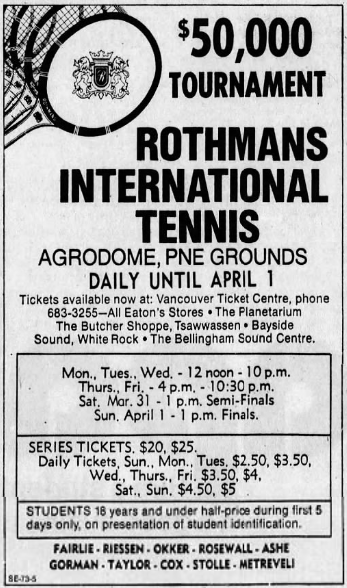In March 1973, Ken Rosewall was 36 years old. He often played like a young man, but there were two decades of top-level tennis in his legs. He bristled against the requirement that players under contract to World Championship Tennis show up for every tournament, week-in, week-out. He had won the WCT circuit finals in both 1971 and 1972, defeating his friend and rival Rod Laver each time. But in 1973, it wasn’t clear if he’d even qualify for the event.
He arrived at the event in Vancouver, British Columbia at the end of March on a meaningless winning streak: He had won the tournament in 1971 but skipped it in ’72. He also showed up cranky. The previous week, organizers in Washington DC had convinced him and Arthur Ashe to try an experiment in their semi-final match. The crowd would be allowed make as much noise as it wanted, whenever it wanted–complete with an announcer to egg them on. Ashe won the match: It didn’t hurt that the Virginia native was essentially playing in front of a home crowd. Rosewall was diplomatic but direct: “It didn’t do anything to help that particular tourney or that match.”
Rosewall–the diminutive “doomsday stroking machine”–was looking for his first title since December and his first championship on the WCT circuit since beating Laver the previous May. There were no experiments in Vancouver, and only a few hundred fans showed up early in the week, anyway. Back in the quiet, Rosewall cruised though the early rounds. He needed only 40 minutes to beat Graham Stilwell and 50 to beat Tom Okker. In the quarters, Raymond Moore was a bit tougher, but the Aussie vet still lost only six games.* Onlookers knew that Rosewall was rounding into form when his backhand lobs started landing inches inside the baseline.
* Before Rosewall played Okker, Moore was asked which opponent he’d rather face. “Sure, I’ve got a preference. I don’t want to play either of them.”
Waiting in the semi-finals was Jan Kodeš, a 27-year-old Czechoslovakian who had never beaten Rosewall in three tries. Yet the surface favored the European. The WCT circuit didn’t concern itself with consistency: Vancouver was the third in a five-tournament string in which the players changed surface every week. Here, they played indoors at the Agrodome, but on a slow court that reminded Kodeš of European clay.
Then again, Rosewall had won the French Open–twice.
Kodeš predicted an extended baseline battle, and the contest on March 31st was exactly that. The two men broke serve 15 times, and the Czech failed to win a single service game in the second set. Yet the underdog survived a first-set tiebreak and bounced back to break in the 8th game of the third set to secure a 7-6, 2-6, 6-3 victory.
Newspapers hailed it as the match of the tournament, and it was certainly that for Kodeš. The following day, the Eastern European found himself against the crowd favorite, Seattle native Tom Gorman, who had beaten Ashe in the early going. Kodeš lost in three, and he said it felt like he was playing in Seattle–even without the authorized crowd noise of the previous week’s event.
Neither Rosewall nor Kodeš left Vancouver with the $10,000 winner’s check, but both men had proved something, if only to themselves. The aging Australian would soon resume his winning ways, and in a few months, the little-known Czechoslovakian would win the biggest title of them all.
* * *
This post is part of my series about the 1973 season, Battles, Boycotts, and Breakouts. Keep up with the project by checking the TennisAbstract.com front page, which shows an up-to-date Table of Contents after I post each installment.
You can also subscribe to the blog to receive each new post by email:

